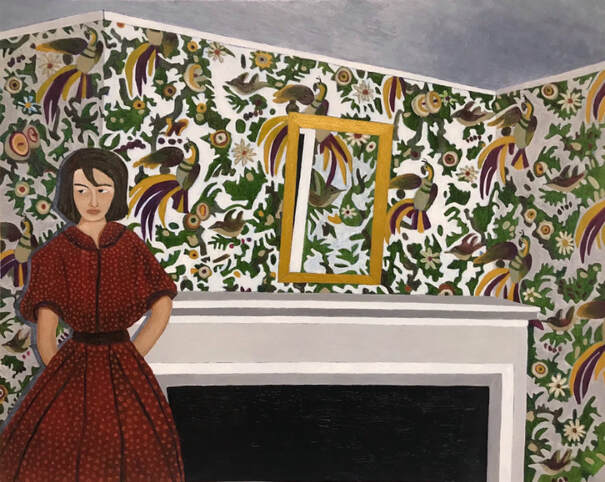|
The Jewel Box In the before days, Gemma’s furtive pleasure was the view out her windows, across the sweep of late summer cornstalks that drew the lines of sight along and then past the creek, forging up the lazy incline of the dusk-blue mountains. She had no desire to leave the confines of her interiors to explore the stark peaks and shadowed valleys, despite ― or because of ― their seductive whispers of beauty and transformation. Better to stay away from the unknown crevices and frightening heights. The possibility of unexplored regions. The fear of no return. The damp terror of wildness. In the beginning days, rumors of the plague had filtered through to Gemma but only in the way that knowledge from a great distance might reach the domain of the uncurious. A shooting star; a foreign tongue; a wasp's sting; the frisson of desire. The roof peak: the thick heavy doors, front and back; the bolted casements: these were the custodians of Gemma’s world. The stillness, the precision, would not be defiled by guests, nor mail delivery, nor telephones, televisions, spurious merchants. Nor men. Never men. With their dirty hands, their mud-crusted boots, their fingerprints on the sanitized surfaces of her unsullied world. The plague seeped like flood waters from cities to suburbs to towns to villages to hamlets to abandoned shacks and animal sheds, uncultivated plains and valleys. A few farmhouses remained, held fast by elderly couples and their mangy dogs, hollowed-out cattle, feral cats. Each day, Gemma shined every facet of the jewel box she called home, as she had for decades: kept the curtains crisp, the cushions plump, the ceilings and crevices free of spider webs and insect trails. She did not collect knick-knacks, hung no photographs of deceased relatives, no clumsy reproductions of fine artworks. The surfaces throughout the rooms of her home were ― like her mind, her body, her inner life ― unadorned. And flawless. However, as perhaps you and I may have predicted, there came an afternoon, deep into the plague years, that Gemma’s polished reality showed signs of tarnish. As weeks and weeks were followed by many more weeks of soothing sameness, portents of slight but perceptible change began to appear. Take note of the gap in the molding between ceiling and wall. Tiny, at first; thin as a silken thread, incidental as a stray pencil stroke; but the next day it was thicker, the width of two pencil strokes; the wood ends pulling away from each other, as though the attraction that once held them close had decayed. Worse: across the room, the hanging wire that anchored the large oak-framed mirror, a decorative but functional object that Gemma tolerated, had shifted a quarter inch to the right. To her horror, this misalignment prompted a visual off-kilter echo, disdaining the perfect geometry of the mantel and the unused fireplace. Gemma, on this occasion that had become unexpectedly distressing, was wearing, as was her habit, one of several outfits she owned that highlighted the spectacular hand-painted wallpaper. The richly saturated garnet hue of her dress picked out and magnified the flashes of a ruby-coloured tail feather in the plumage of the pheasants repeated throughout the vibrant motif. But now it's slipping away and it's more than she can bear: the purity, the hard-won perfection and even worse, the day-to-day struggle to stave off any hint of fallibility in her singular aesthetic victory. The tilted mirror; the flaws in the ceiling molding; the dimmed-down glow of her brilliant achievement. Her lovely outfit brings no joy to Gemma. The plague has come to her; and even in this faultless shelter, she must open the door to pain, sorrow, lust, derangement, and death. Life and its beauty lie not in containment or control, but in opening up and letting go. Susan T. Landry Susan T. Landry is a semi-retired medical manuscript and creative writing editor. She writes for pleasure, and has published poetry, fiction, and memoir. She lives in Maine, USA, reads voraciously, and travels whenever possible. Brigid Kennedy is a contemporary American artist, born and raised in Western New York. Kennedy creates work across multiple disciplines including painting, sculpture and drawing. Her recent paintings examine today’s social and cultural challenges, memory and the visual complexity of daily life. Kennedy received her Bachelors of Arts degree in Philosophy from the University of Toronto, her Bachelors of Fine Arts degree from the State University of New York at Buffalo, and her Master of Fine Arts degree in Sculpture from Yale University School of Art.
0 Comments
Your comment will be posted after it is approved.
Leave a Reply. |
The Ekphrastic Review
COOKIES/PRIVACY
This site uses cookies to deliver your best navigation experience this time and next. Continuing here means you consent to cookies. Thank you. Join us on Facebook:
July 2024
|




